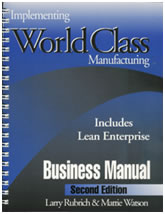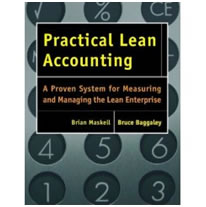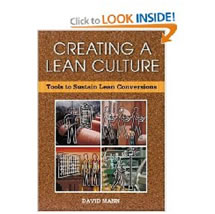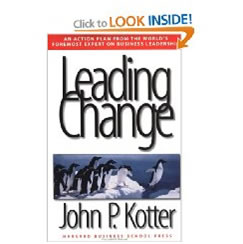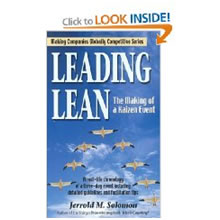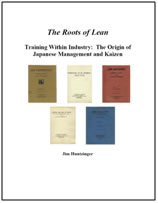LEAN Literature |
|
Implementing World Class Manufacturing - 2nd Edition by Larry Rubrich & Mattie Watson. In our Second Edition, the application of the waste elimination techniques of Lean and World Class Manufacturing have been expanded to include all parts of manufacturing businesses (the office also) and to all types of business in general. This business manual teaches leadership, empowerment, and the advanced manufacturing techniques required to secure your future, today! 437 Pages, Wirebound. |
|
In Getting the Right Things Done, Pascal Dennis outlines the nuts and bolts of strategy deployment, answering two tough questions that ultimately can make or break a lean transformation: What kind of planning system is required to inspire meaningful company-wide continuous improvement? How might we change existing mental models that do not support a culture of continuous improvement? The book provides readers with a framework for understanding the key components of strategy deployment: agreeing on True North for the company, working within the PDCA cycle, getting consensus through catchball, the deployment leader concept, and A3 thinking. It links action to theory and reminds us that lean tools are only the means to an end, not ends in themselves. |
|
Managing to Learn by Toyota veteran John Shook, reveals the thinking underlying the vital A3 management process at the heart of lean management and lean leadership. The book explains how A3 thinking helps managers and executives identify, frame, and then act on problems and challenges. Shook calls this approach the key to Toyota's entire system of developing talent and continually deepening its knowledge and capabilities. The widespread adoption of the A3 process standardizes a methodology for innovating, planning, problem-solving, and building foundational structures for sharing a broader and deeper form of thinking that produces organizational learning deeply rooted in the work itself, says Shook. |
|
Practical Lean Accounting - As companies move ahead with the implementation of lean production, financial functions often lag behind. When this happens, not only do they fail to actively support the effort, but they can actually hinder it. In Practical Lean Accounting: A Proven System for Measuring and Managing the Lean Enterprise, authors Brian Maskell and Bruce Baggaley present a step-by-step method for transforming a manufacturing company's financial functions to support lean manufacturing. This step-by-step method transforms the accounting system to follow the company's pathway through lean implementation covering what needs to be done at each stage to support lean. Practical Lean Accounting is a valuable tool for CFOs, Controllers, accounting staff, and general managers that use key financial information to control their processes and support lean |
|
Lean Office Demystified - conveys the proven success of the Toyota Production System for administrative processes. This book includes the best selling The 5S Desktop (PC) Pocket Handbook inside the back cover. The forms, graphs, illustrations, and worksheets are organized in a step-by-step manner in which anyone can apply these principles to the office. Each phase also includes a Readiness Guide that ensures you are ready to proceed to the next level. This book provides the complete blueprint, from start to finish, for planning and implementing your administrative improvements while maximizing employee performance. The Lean tools are defined relative to examples from manufacturing front offices, healthcare and its associated clinics and labs, as well as the financial services industry. This book provides all the necessary tools for you to achieve a Lean Office. |
|
Creating a Lean Culture - Lean production has been proven unbeatable in organizing production operations, yet the majority of attempts to implement lean end in disappointing results. The critical factor so often overlooked is that lean implementation requires day-to-day, hour-by-hour management practices and skills that leaders in conventional batch-and-queue environments are neither familiar nor comfortable with. Mann provides critical guidance on developing and using the key elements of a lean management system, including: leader standard work, visual controls, daily accountability processes, maintaining a process focus, managing key HR issues, and much more. The book describes and illustrates 4 key principles of lean management: leader standard work; visual controls; daily accountability process, and discipline. Shows how visual controls bring process focus to life, tie in lean's requirement for highly disciplined execution, and make leaders' new jobs far easier to explain, model and evaluate. |
|
Leading Change - Harvard Business School professor Kotter (A Force for Change) breaks from the mold of M.B.A. jargon-filled texts to produce a truly accessible, clear and visionary guide to the business world's buzzword for the late '90s?change. Kotter emphasizes a comprehensive eight-step framework that can be followed by executives at all levels. Kotter advises those who would implement change to foster a sense of urgency within the organization. "A higher rate of urgency does not imply everpresent panic, anxiety, or fear. It means a state in which complacency is virtually absent." Twenty-first century business change must overcome overmanaged and underled cultures. "Because management deals mostly with the status quo and leadership deals mostly with change, in the next century we are going to have to try to become much more skilled at creating leaders." Kotter convincingly argues for the promotion and recognition of teams rather than individuals. He aptly concludes with an emphasis on lifelong learning. |
|
Leading Lean-The Making of a Kaizen Event, by Jerrold Solomon (Shingo Prize Winning Author of Who’s Counting? A Lean Accounting Business Novel) is the second in a series of business novels about the Lean transformation process at Tricor Electronics, a fictional company. It follows the characters originally introduced in Who’s Counting? and exposes the human interactions that occur during any Lean transformation. Leading Lean illustrates the angst people go through when asked to change, demonstrates the teamwork and leadership required, exposes the paradigms that must be changed, and lays bare the unwavering commitment required from everyone, especially the CEO. It brings to life the unending stream of interpersonal challenges as the novel chronicles the hour-by-hour progression of a three-day 5S event. Leading Lean demonstrates the critical role a trained facilitator plays in successfully navigating the Lean transformation and provides a road map that will enable your company to compete more effectively in the 21st century. |
|
|
The Roots of Lean - A review of some basic philosophies of Japanese management and kaizen proves that they are actually an evolution of a training technique developed nearly ninety years earlier in the United States. The techniques have evolved through the TWI programs of WWII and their infiltration into Japanese industry by the Allied occupational forces. They continued to evolve in post-war-Japan through today to become some of the most successful management techniques in use today in industry. |

